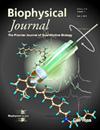Cholesterol Allosteric Modulation of the Oxytocin Receptor.
IF 3.2
3区 生物学
Q2 BIOPHYSICS
引用次数: 0
Abstract
G-protein coupled receptors (GPCRs) are critical components in cellular signaling, mediating various physiological responses to external stimuli. Here, we investigate the intricate relationship between cholesterol and the oxytocin receptor (OXTR), focusing on the binding mechanisms and the allosteric crosstalk of bound cholesterol to the orthosteric ligand binding pocket. Utilizing molecular docking and molecular dynamics simulations, we identify cholesterol binding sites both on the agonist-bound and antagonist-bound state, which show differing distributions and residence times of the cholesterol molecules. Importantly, both methods converge on several key sites, demonstrating strong predictive overlap. Notably, one such site, and several sites detected by our MD approach, also coincides with electron density observed in an experimental cryo-EM map, providing orthogonal validation for computational predictions. Allosteric network analysis uncovers the distinct pathways through which cholesterol may affect ligand mediated receptor signaling, highlighting the significance of one site on the extracellular leaflet between TM4 and TM5, and two sites on the intracellular leaflet between TM2, TM3, and TM4 and between TM4 and TM5 in transmitting allosteric signals to the orthosteric pocket. These findings provide insights into the impact of cholesterol on OXTR function, emphasizing specific binding sites and signaling paths for further experimental exploration.催产素受体的胆固醇变构调节。
g蛋白偶联受体(gpcr)是细胞信号传导的重要组成部分,介导对外界刺激的各种生理反应。在这里,我们研究了胆固醇和催产素受体(OXTR)之间的复杂关系,重点研究了结合的胆固醇与正构配体结合袋的结合机制和变构串扰。利用分子对接和分子动力学模拟,我们确定了激动剂结合和拮抗剂结合状态下的胆固醇结合位点,这些位点显示了胆固醇分子的不同分布和停留时间。重要的是,这两种方法在几个关键位点上收敛,显示出很强的预测重叠。值得注意的是,我们的MD方法检测到的一个这样的位点和几个位点也与实验低温电镜图中观察到的电子密度相吻合,为计算预测提供了正交验证。变构网络分析揭示了胆固醇可能影响配体介导的受体信号转导的不同途径,强调了细胞外小叶上TM4和TM5之间的一个位点,细胞内小叶上TM2、TM3和TM4之间以及TM4和TM5之间的两个位点在向正构袋传递变构信号方面的重要性。这些发现为胆固醇对OXTR功能的影响提供了新的见解,强调了具体的结合位点和信号通路,供进一步的实验探索。
本文章由计算机程序翻译,如有差异,请以英文原文为准。
求助全文
约1分钟内获得全文
求助全文
来源期刊

Biophysical journal
生物-生物物理
CiteScore
6.10
自引率
5.90%
发文量
3090
审稿时长
2 months
期刊介绍:
BJ publishes original articles, letters, and perspectives on important problems in modern biophysics. The papers should be written so as to be of interest to a broad community of biophysicists. BJ welcomes experimental studies that employ quantitative physical approaches for the study of biological systems, including or spanning scales from molecule to whole organism. Experimental studies of a purely descriptive or phenomenological nature, with no theoretical or mechanistic underpinning, are not appropriate for publication in BJ. Theoretical studies should offer new insights into the understanding ofexperimental results or suggest new experimentally testable hypotheses. Articles reporting significant methodological or technological advances, which have potential to open new areas of biophysical investigation, are also suitable for publication in BJ. Papers describing improvements in accuracy or speed of existing methods or extra detail within methods described previously are not suitable for BJ.
 求助内容:
求助内容: 应助结果提醒方式:
应助结果提醒方式:


